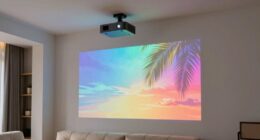LED lighting has the potential to harm eyesight because of the blue light emissions it produces. This type of light can cause digital eye strain, disrupt sleep patterns, and even lead to conditions like retinal damage and macular degeneration over time. To safeguard eye health, it is recommended to opt for LED lights with lower blue light levels, take breaks from screens, and utilize blue light filters. Regular check-ups and being conscious of exposure to LED lighting can help in maintaining optimal eye health and reducing risks. Understanding the effects of blue light is essential in protecting eye health, and there are strategies available to minimize the potential harm from LED lighting.
Key Takeaways
- Blue light emissions from LEDs can harm eyesight.
- Overexposure to blue light may cause retinal damage.
- LED lighting can contribute to digital eye strain.
- Prolonged LED exposure can disrupt sleep patterns.
- Choosing LED lights with lower blue light emission levels can mitigate risks.
Understanding LED Light Emissions
LEDs emit blue light primarily because of the bandgap in the semiconductor material they utilize. This blue light, while energy-efficient, can potentially harm the eyes. The high energy and short wavelength of blue light allow it to penetrate deeply into the eye, reaching the retina and potentially causing retinal damage.
Overexposure to blue light from LEDs is also linked to digital eye strain, a common condition characterized by discomfort and vision problems after staring at screens for extended periods. Additionally, prolonged exposure to blue light from LEDs may contribute to age-related macular degeneration, a leading cause of vision loss in older adults.
To address these concerns, some LEDs are designed with lower blue light emissions, aiming to reduce the potential negative impact on eye health. By understanding the correlation between semiconductor material, LED light emissions, and the risks associated with overexposure to blue light, individuals can make informed choices to protect their eye health while benefiting from the advancements in lighting technology.
Impact of Blue Light on Eyes

Blue light emitted by LED lighting can penetrate the retina, potentially causing retinal damage. Overexposure to this blue light may lead to digital eye strain and discomfort, with prolonged exposure possibly contributing to age-related macular degeneration.
Balancing and managing blue light exposure is essential for maintaining good eye health when utilizing LED lights.
Blue Light Effects
Excessive exposure to blue light emitted by lighting sources like LEDs can potentially harm the eyes by penetrating the retina and causing various vision-related issues. Blue light effects include:
- Retinal Damage: Blue light from LEDs can reach the retina, potentially leading to damage.
- Eye Strain: Overexposure to blue light can cause digital eye strain and discomfort.
- Macular Degeneration: Prolonged exposure to blue light may contribute to age-related macular degeneration.
- High Blue Light Emission: LEDs emit high levels of blue light due to their semiconductor material.
It's essential to be mindful of the amount of blue light exposure from LED lights to maintain good eye health and reduce the risk of potential issues.
Eye Strain Concerns
Moreover, blue light emitted by LED lights can contribute to digital eye strain, leading to symptoms such as dry eyes and headaches. Prolonged exposure to this type of light may disrupt the sleep-wake cycle by suppressing melatonin production.
Additionally, blue light can penetrate deeply into the eye, potentially causing damage to the retina over time. Research indicates that blue light from LED sources can also play a role in age-related macular degeneration, a leading cause of vision loss.
To mitigate these effects, individuals can take breaks, use blue light filters, and adjust screen brightness when exposed to LED lighting.
Vision Health Risks
LED lighting poses significant risks to vision health due to its high emission of blue light. This type of light can potentially lead to retinal damage and age-related macular degeneration over time. Blue light from LEDs has the ability to penetrate the retina, causing long-term harm with prolonged exposure. This might contribute to age-related macular degeneration, impacting overall eye health.
Additionally, overexposure to blue light can result in digital eye strain, causing discomfort and affecting vision. LED lights emit a substantial amount of blue light due to their semiconductor technology, intensifying the risk of blue light exposure. Understanding these vision health risks is essential for maintaining good eye health and preventing potential long-term damage.
Risks of Prolonged LED Exposure

Prolonged exposure to blue light emitted by LED lighting can have detrimental effects on eye health, including digital eye strain and disruption of sleep patterns. The blue light from LEDs may lead to eye damage, such as retinal damage and an increased risk of eye diseases with chronic exposure. Studies also suggest that over time, continuous exposure to LED lights could contribute to vision problems.
To mitigate these risks, individuals can adopt protective measures like taking regular breaks from screens and using blue light filters on devices. Additionally, it's important to be mindful of the impact of LED lighting on melatonin production, which plays a significant role in regulating sleep. By being proactive in managing exposure to blue light from LEDs, individuals can help safeguard their eye health and potentially reduce the long-term effects associated with prolonged LED exposure.
Effects on Circadian Rhythm

Excessive exposure to blue light emitted by LED lighting can disrupt the body's natural sleep-wake cycle, impacting overall health and well-being. The effects of blue light on the circadian rhythm can have significant implications for sleep patterns and quality. Key points to keep in mind include:
- Blue light suppresses melatonin production, affecting the regulation of sleep-wake cycles.
- Research indicates that excessive evening exposure to blue light can delay sleep onset and reduce overall sleep duration.
- Disruption of the circadian rhythm by LED lighting may contribute to insomnia, fatigue, and other sleep-related issues.
- Limiting exposure to blue light, especially in the evening from LED screens and lighting, is essential for maintaining a healthy circadian rhythm and improving sleep quality.
Understanding the impact of blue light on the circadian rhythm is essential for individuals looking to optimize their sleep-wake cycles and overall well-being.
Strategies to Protect Eye Health

LED lighting can impact eye health, but there are strategies to protect your eyesight. Choosing warm color temperatures and using screen filters can reduce blue light exposure.
Managing screen time, positioning lights strategically, and considering blue light blocking glasses are all effective ways to maintain eye health in the face of LED lighting challenges.
Eye-Friendly Lighting Tips
To protect eye health, incorporating eye-friendly lighting tips can greatly benefit individuals exposed to LED lights. Consider the following tips:
- Choose warm color temperature LED lights to minimize blue light exposure.
- Use light filters or adjust brightness settings to reduce the impact of blue light on your eyes.
- Take breaks from screens and maintain a distance from bright LED lights to prevent eye strain.
- Opt for LED lights with lower blue light emission to decrease the risk of retinal damage and digital eye strain.
For a comfortable lighting environment, you can explore eye-friendly LED light options like Philips Hue White and Color Ambiance bulbs. These strategies can help safeguard your eyes from the potential harms associated with LED lighting.
Blue Light Protection
Positioning LED lights to bounce off walls or ceilings can help diffuse the intensity of blue light, aiding in the protection of eye health. To further shield your eyes from blue light exposure, consider using blue light filters on screens and following the 20-20-20 rule. Additionally, opting for LEDs with lower blue light emissions and adjusting brightness settings can minimize eye strain. By implementing these strategies, you can safeguard your eye health from the potential negative effects of blue light. Below is a table summarizing key ways to protect your eyes from blue light:
| Blue Light Protection Strategies |
|---|
| Use blue light filters |
| Position LED lights to bounce off walls or ceilings |
| Follow the 20-20-20 rule for eye breaks |
| Opt for LEDs with lower blue light emissions |
| Adjust brightness settings |
Screen Time Management
Considering the harmful impact of prolonged screen exposure on eye health, implementing effective screen time management strategies is essential for maintaining excellent visual well-being. To protect your eyes from the negative effects of screens, consider the following tips:
- Take breaks every 20 minutes to reduce eye strain and fatigue.
- Adjust screen brightness settings, especially during evening hours.
- Use blue light filters or night mode features to minimize blue light exposure.
- Follow the 20-20-20 rule: every 20 minutes, look at something 20 feet away for 20 seconds.
Additionally, wearing blue light blocking glasses can offer extra protection against prolonged screen exposure. By incorporating these strategies into your daily routine, you can help safeguard your eyes from the potential risks associated with excessive screen time.
Choosing Eye-Friendly LED Lighting

When choosing LED lighting for the best eye health, prioritize warm color temperature bulbs to minimize blue light exposure. Opting for LED lights with lower blue light emission levels can help reduce eye strain and promote overall eye-friendly environments.
Brands like Philips Hue White and Color Ambiance offer options designed to support eye health by providing comfortable lighting experiences. To further protect your eyes, consider using light filters or adjusting the brightness settings on LED lights.
It's also essential to maintain a safe distance between your eyes and the LED lights to minimize direct exposure and potential harm. By being mindful of the color temperature, blue light emission levels, and utilizing recommended products or adjustments, individuals can create eye-friendly spaces that prioritize eye health and well-being.
Importance of Regular Eye Check-Ups

Regular eye check-ups play an important role in maintaining excellent eye health and detecting any potential issues early on. Optometrists recommend routine eye exams to monitor changes and spot early signs of eye diseases or conditions that may be aggravated by LED light exposure. Here are some key reasons why regular eye check-ups are significant:
- Early Detection: Eye exams can help in the early detection and management of any eye health issues related to LED light exposure.
- Preventive Measures: Optometrists can provide guidance on protecting your eyes from potential harm caused by LED lighting.
- Monitoring Changes: Regular eye check-ups are essential for monitoring any changes in vision or eye health.
- Optimal Eye Health: Routine eye exams ensure that your eyes are healthy and functioning well despite exposure to LED lights.
Balancing LED Benefits and Risks

To strike a balance between the benefits and risks of LED lighting, understanding the impact of blue light on eyesight is essential. LED lights are known for their energy efficiency and durability, but they can emit blue light that has been linked to eye strain and potential retinal damage. Studies suggest that prolonged exposure to blue light from LEDs may disrupt sleep patterns and contribute to eye health issues. Hence, it's important to take into account the potential risks to eyesight while enjoying the benefits of LED lighting.
One way to mitigate these risks is by choosing LED lights with lower blue light emissions. Additionally, implementing protective measures such as using anti-glare screens or adjusting the lighting intensity can help reduce the strain on the eyes. By understanding the impact of blue light from LED lighting on eyesight and taking preventive steps, individuals can maintain their eye health while benefiting from the energy efficiency and longevity of LED lights.
Frequently Asked Questions
How Bad Are LED Lights for Your Eyes?
LED lights emit high levels of blue light, potentially harming eyes over time. Prolonged exposure may lead to digital eye strain, disrupted sleep patterns, and retinal damage.
Overexposure can contribute to age-related macular degeneration. It's essential to be mindful of these risks and take precautions to protect eye health.
LED lights' impact on eyesight can be significant, necessitating awareness and appropriate measures for eye safety.
How Do You Protect Your Eyes From LED Lights?
To protect eyes from LED lights, position them strategically to avoid glare and reduce intensity. Take regular breaks from screens to prevent digital eye strain. Consider using blue light filters on devices or invest in blue light blocking glasses for added protection.
Opt for warmer color temperature LEDs to minimize blue light exposure and reduce eye strain. These measures can help maintain eye health and reduce the potential harm caused by LED lighting.
What Are the Harmful Effects of LED Lights?
LED lights emit high levels of blue light, which can lead to digital eye strain, disrupt sleep patterns, and potentially damage the retina. Prolonged exposure to blue light from LEDs may contribute to age-related macular degeneration.
Research indicates a link between blue light exposure from LEDs and various eye health concerns, causing glare, eye strain, headaches, and impacting overall eye health.
Precautions like using blue light filters and following the 20-20-20 rule can help mitigate these effects.
Can LED Flashlights Cause Eye Damage?
LED flashlights can potentially cause eye damage due to their high levels of blue light. Prolonged exposure to intense blue light can lead to digital eye strain, fatigue, and disrupt the sleep-wake cycle.
The focused beam of LED flashlights may create glare and reflections that strain the eyes. Using LED flashlights with adjustable brightness settings can help mitigate the risk of eye damage.
It's important to be mindful of the potential impact on eye health when using LED flashlights.
Conclusion
To sum up, it's crucial to be mindful of potential risks to eye health from prolonged exposure to LED lighting.
Blue light emissions can affect eyesight and disrupt circadian rhythms, but by incorporating eye-friendly LED lighting and scheduling regular check-ups, these concerns can be minimized.
By weighing the advantages and drawbacks of LED technology, individuals can benefit from energy-efficient lighting without compromising their eye health.
Remember, safeguarding your eyes is just as vital as enjoying the convenience of modern technology.






